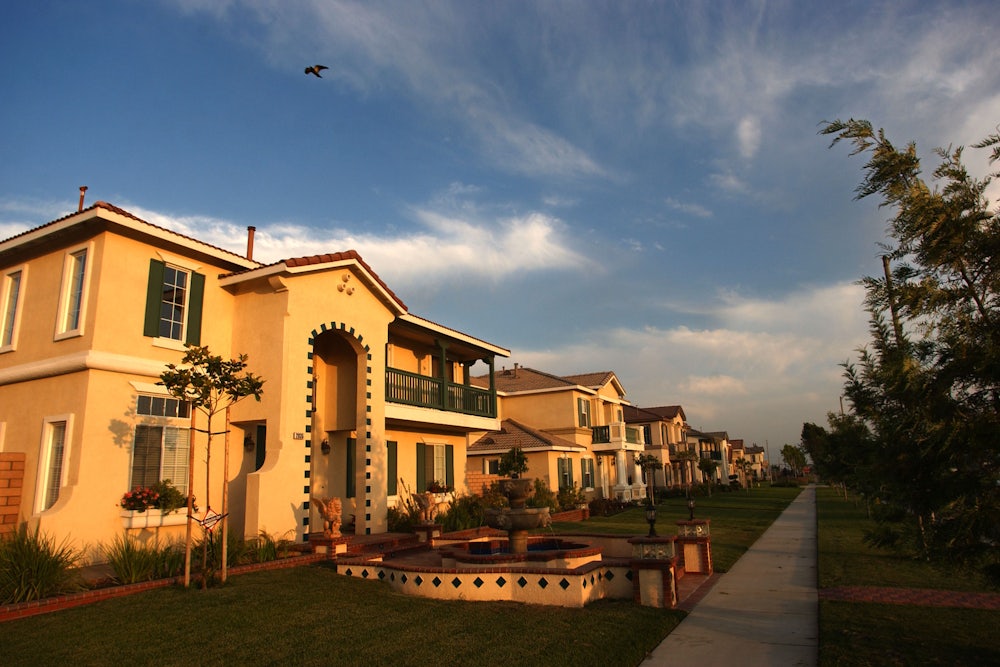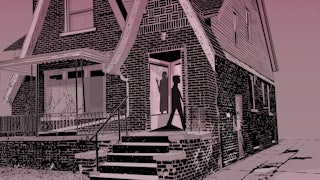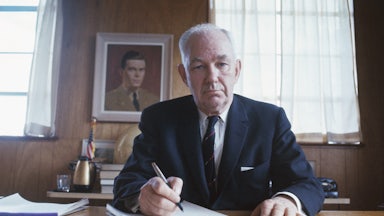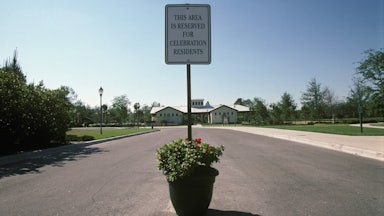Dismantling segregation in the United States has proven exceedingly difficult. In 1966, when Martin Luther King Jr. and fellow marchers were pelted with rocks and bottles in a fair housing demonstration in Chicago, King said he saw a level of hatred far greater than in campaigns for voting rights or nondiscrimination in employment. King persisted, Sheryll Cashin writes in her searing new book, White Space, Black Hood, because he and others knew that housing segregation was the fountainhead of so many other inequities, including unequal access to good schools, jobs, health care, safe neighborhoods, and fair policing.
More than 50 years later, as Americans seek to address long-standing racial inequities, Cashin makes a powerful case that housing desegregation must remain central to the path forward. A longtime civil rights activist, Cashin was a clerk for Supreme Court Justice Thurgood Marshall and an adviser to Bill Clinton (who, it must be said, does not come off very well in this book). Now the Carmack Waterhouse Professor of Law, Civil Rights and Social Justice at Georgetown, Cashin has written an astounding book that combines engaging storytelling and powerful empirical evidence to address the civil rights movement’s most pressing piece of unfinished business.
In the U.S., Cashin notes, there is an underlying cultural assumption that people live where they deserve to, “that affluent space is earned and hood living is the deserved consequence of individual behavior.” Emblematic of this thinking, Cashin shrewdly observes, is the way the term ghetto has morphed from a noun to an adjective. Whereas ghetto once connoted an enforced separation of a people, whether Jews in sixteenth-century Venice or Black people in modern America, today it is also “a pejorative” used to describe “dress, speech and social codes” that are rejected by middle-class Americans.
Cashin brings to bear considerable evidence to show that poor neighborhoods are not the natural result of sorting by merit; to the contrary, both Black and white spaces in America have been socially engineered by government. Consider Baltimore, which is today highly segregated by race and class. It was not always thus, Cashin writes. Working-class white and Black people were reasonably integrated in the late nineteenth century. When George W.F. McMechen, a Black Yale Law graduate, moved into a white upper-middle-class neighborhood in the early twentieth century, however, white families reacted with violence and legislation. “Whites threw stones and bricks into the McMechens’ new home,” Cashin writes, and Baltimore’s mayor, J. Barry Mahool, championed the nation’s first racial zoning legislation, which banned Black people from moving into white neighborhoods.
Mahool did not mince words. “Blacks should be quarantined in isolated slums in order to reduce the incidents of civil disturbance, to prevent the spread of communicable disease into the nearby White neighborhoods and to protect property values among the White majority,” he declared. The New York Times article about the ordinance, Cashin notes, “featured an image of the handsome, dapper, and presumably disease-free McMechen.”
Although the U.S. Supreme Court struck down racial zoning as a violation of the Constitution in 1917, segregationists in Baltimore and elsewhere employed a slew of additional tactics: racially restrictive covenants (which were not struck down until 1948), redlining (which was not made illegal until 1968), and economically exclusionary zoning (which exists to this day). Whites also fought efforts to place public housing in middle-class neighborhoods; in fact, in 1994, the otherwise liberal Maryland U.S. Senator Barbara Mikulski killed a federal program that provided the opportunity for low-income families, many of them Black, to live in upper-middle-class areas in the Baltimore region and elsewhere.
The broad outlines of this story of racial exclusion will be familiar to many readers through the superb work of authors such as Ta-Nehisi Coates and Richard Rothstein. But Cashin is also alert to the rising significance of economic discrimination and segregation that disproportionately hurt Black people.
Cashin writes that the civil rights revolution brought real success, but only to a subset of the Black population. Anti-discrimination laws helped transform the profile of America’s Black population, she says: “Before the movement, the majority of Blacks were poor. Today, a large majority of Black Americans are not poor.” The additional good news is that with passage of the Fair Housing Act, middle-class Black Americans gained the ability to migrate out of poor neighborhoods, and the Black-White dissimilarity index (in which 100 is apartheid and 0 is perfect integration) declined from 79 in 1970 to 55 by 2020. The proportion of metropolitan-area Black people living in hypersegregated environments was cut roughly in half, from 61 percent to 32 percent, between 1970 and 2010. Today, a Black Yale Law graduate like George W.F. McMechen can purchase a home in a more affluent neighborhood; indeed, says Cashin, between 1970 and 2009, “the percentage of middle-class or affluent Blacks who lived in islands of advantage grew from 12 percent to 34 percent.”
But it’s hardly time to declare victory. The bad news, Cashin points out, is that “the truly disadvantaged descendants of slaves are Black Americans stuck in neighborhoods that higher-income Blacks have fled.” Those left behind, as Harvard’s William Julius Wilson has observed, have become worse off after “the exit of middle-class and professional Blacks from poor neighborhoods.”
Economic segregation has grown within the Black population and within America as a whole. Cashin cites Rutgers Professor Paul Jargowsky’s finding that the number of people living in concentrated poverty increased by 91 percent in the first decade and a half of the twenty-first century. While the press has focused a great deal of attention on a small number of high-profile gentrifying areas of cities, Cashin shows that gentrification and displacement is only one head in the hydra of housing injustice. In Baltimore, for instance, “four people lived in a neighborhood that was declining for each person who lived in a reviving or gentrifying area.” Meanwhile, the affluent and highly educated have increasingly sealed themselves off in high-opportunity neighborhoods where the government invests more money in the education of children, who are largely protected “from competition from everyone else.”
Class discrimination overlaps with and compounds racial segregation. Poor white Americans tend to be more economically integrated than poor Black Americans. At the same time, in those areas where poor whites are isolated and concentrated, they experience many of the same “social ills” as those who live in poor Black neighborhoods, Cashin observes. Many readers know that race was unconscionably used in redlining maps, but Cashin notes that class was part of the equation, too. In the A–D rating system for insuring mortgages, for example, middle-class Black areas received a blue B rating (“Still Desirable”), while poor Black areas received the worst red D rating (“Hazardous”).
Nimby forces will push back on Cashin’s argument by countering that today’s exclusionary zoning preventing the construction of more affordable multifamily housing is not racist or classist but rather a mechanism for preserving low crime levels and high property values found in thriving communities. But as Cashin argues, painting all disadvantaged people as potential criminal threats is deeply unfair. Most violent crime, researchers find, is committed by “a tiny group of people who are linked together in a tight network of victims and offenders.” As Cashin makes clear, “The narrative of pathology blames the people who lost the neighborhood lottery … and masks a legacy of intentional state discrimination in creating ghettos.”
Researchers who have examined the effects of low-income housing on property values, likewise, have found that the fears of middle-class whites are overblown. More to the point, quarantining Black and low-income people as a threat to “property values” is precisely the type of ugly thinking that was used to justify redlining and racial zoning policies. Our fundamental goal, writes Cashin, must be to change policy and culture “to transform the lens through which society sees residents of poor Black neighborhoods, from presumed thug to presumed citizen.”
What is to be done? Cashin would seek to ameliorate the effects of segregation by providing a universal basic income and tripling federal Title I investments into high-poverty schools. Her primary goal, however, is to dismantle segregation itself. She is a strong supporter of the Fair Housing Act’s requirement to “affirmatively further fair housing,” which calls upon local jurisdictions to take steps to integrate housing as a condition for receiving federal funds. And she would go beyond that to bar exclusionary zoning policies that discriminate on the basis of income as well as race. Cashin acknowledges that the politics of change are tough but points out that some jurisdictions, such as Minneapolis and Oregon, have stunned cynics by legalizing duplexes and triplexes in areas that had been previously reserved exclusively for single-family homes.
Cashin is hopeful that, at long last, the nation may be ready to take on Dr. King’s call to remedy racial segregation in housing. “Despite backlash and fatigue,” Cashin writes, “Black Americans have more allies than they have ever had in US history.” And policies that simultaneously confront both racial and economic discrimination in zoning, she notes, would broaden the coalition of self-interest to include “the vast majority of people,” who are shut out of residential “bastions of affluence.”
White Space, Black Hood makes a powerful case that “geography as caste is destroying America.” It will be impossible to heal the soul of the country without addressing the defining problem this extraordinary book illuminates.






